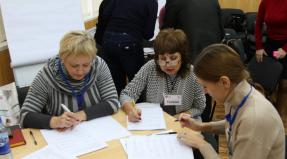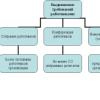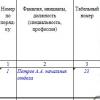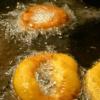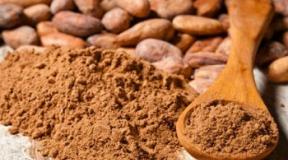A regular quadrangular prism described around the ball. Straight prism (rectangular regular). Ball and prism
The topic "Different problems for polyhedra, cylinder, cone and ball" is one of the most difficult in the 11th grade geometry course. Before solving geometric problems, they usually study the relevant sections of the theory, which are referred to when solving problems. In the textbook by S. Atanasyan et al. On this topic (p. 138), one can find only definitions of a polyhedron described around a sphere, a polyhedron inscribed in a sphere, a sphere inscribed in a polyhedron, and a sphere described near a polyhedron. The methodological recommendations for this textbook (see the book “Studying geometry in 10-11 grades” by S.M. Sahakyan and V.F.Butuzov, p. 159) says which combinations of bodies are considered when solving problems No. 629-646 , and attention is drawn to the fact that “when solving a particular problem, first of all, it is necessary to ensure that the students have a good idea of the mutual arrangement of the bodies indicated in the condition”. The following is the solution to problems No. 638 (a) and No. 640.
Taking into account all of the above, and the fact that the most difficult tasks for students are the problems of combining a ball with other bodies, it is necessary to systematize the corresponding theoretical provisions and communicate them to the students.
Definitions.
1. A ball is called inscribed in a polyhedron, and a polyhedron is called circumscribed about a ball if the surface of the ball touches all faces of the polyhedron.
2. A ball is called circumscribed about a polyhedron, and a polyhedron is called inscribed in a ball if the surface of the ball passes through all the vertices of the polyhedron.
3. A ball is called inscribed in a cylinder, a truncated cone (cone), and a cylinder, a truncated cone (cone), is described near the ball if the surface of the ball touches the bases (base) and all generatrices of the cylinder, truncated cone (cone).
(It follows from this definition that the great circle of the ball can be inscribed in any axial section of these bodies).
4. A ball is called circumscribed about a cylinder, a truncated cone (cone), if the base circles (base circle and apex) belong to the surface of the ball.
(From this definition it follows that about any axial section of these bodies the circumference of a larger circle of the ball can be described).
General remarks about the position of the center of the ball.
1. The center of a ball inscribed in a polyhedron lies at the intersection point of the bisector planes of all dihedral angles of the polyhedron. It is located only inside the polyhedron.
2. The center of the ball circumscribed about the polyhedron lies at the intersection of the planes perpendicular to all edges of the polyhedron and passing through their midpoints. It can be located inside, on the surface, and outside the polyhedron.
Combination of a ball with a prism.
1. A ball inscribed in a straight prism.
Theorem 1. A ball can be inscribed into a straight prism if and only if a circle can be inscribed into the base of the prism, and the height of the prism is equal to the diameter of this circle.
Corollary 1. The center of the ball inscribed in a straight prism lies in the middle of the height of the prism passing through the center of the circle inscribed in the base.
Corollary 2. The ball, in particular, can be inscribed in straight lines: triangular, regular, quadrangular (in which the sums of the opposite sides of the base are equal to each other), provided H = 2r, where H is the height of the prism, r is the radius of the circle inscribed in the base.
2. A ball circumscribed about a prism.
Theorem 2. A ball can be described near a prism if and only if the prism is straight and a circle can be described near its base.
Corollary 1... The center of the ball described about a straight prism lies in the middle of the height of the prism drawn through the center of the circle described about the base.
Corollary 2. The ball, in particular, can be described: near a straight triangular prism, near a regular prism, near a rectangular parallelepiped, near a straight quadrangular prism, in which the sum of the opposite angles of the base is 180 degrees.
From L.S. Atanasyan's textbook on the combination of a ball with a prism, one can suggest problems No. 632, 633, 634, 637 (a), 639 (a, b).
Combination of a ball with a pyramid.
1. A ball described around a pyramid.
Theorem 3. A ball can be described near a pyramid if and only if a circle can be described near its base.
Corollary 1. The center of the ball circumscribed about the pyramid lies at the point of intersection of a line perpendicular to the base of the pyramid passing through the center of the circle circumscribed about this base and a plane perpendicular to any lateral edge drawn through the middle of this edge.
Corollary 2. If the side edges of the pyramid are equal to each other (or equally inclined to the plane of the base), then a ball can be described around such a pyramid. The center of this ball in this case lies at the point of intersection of the height of the pyramid (or its continuation) with the axis of symmetry of the side edge lying in the plane lateral rib and height.
Corollary 3. The ball, in particular, can be described: near a triangular pyramid, near a regular pyramid, near a quadrangular pyramid, in which the sum of opposite angles is 180 degrees.
2. A ball inscribed in a pyramid.
Theorem 4. If the side faces of the pyramid are equally inclined to the base, then a ball can be inscribed into such a pyramid.
Corollary 1. The center of the ball inscribed in the pyramid, whose side faces are equally inclined to the base, lies at the intersection of the pyramid height with the bisector of the linear angle of any dihedral angle at the base of the pyramid, the side of which is the height of the side face drawn from the top of the pyramid.
Corollary 2. A ball can be inscribed in a regular pyramid.
From L.S. Atanasyan's textbook on the combination of a ball with a pyramid, one can suggest problems No. 635, 637 (b), 638, 639 (c), 640, 641.
Combination of a ball with a truncated pyramid.
1. A ball circumscribed about a regular truncated pyramid.
Theorem 5. A sphere can be described around any regular truncated pyramid. (This condition is sufficient, but not necessary)
2. A ball inscribed in a regular truncated pyramid.
Theorem 6. A ball can be inscribed into a regular truncated pyramid if and only if the apothem of the pyramid is equal to the sum of the apothems of the bases.
There is only one problem for the combination of a ball with a truncated pyramid in L.S. Atanasyan's textbook (no. 636).
A combination of a ball with round bodies.
Theorem 7. A ball can be described around a cylinder, a truncated cone (straight circular), or a cone.
Theorem 8. A ball can be inscribed in a cylinder (straight circular) if and only if the cylinder is equilateral.
Theorem 9. A ball can be inscribed in any cone (straight circular).
Theorem 10. A ball can be inscribed into a truncated cone (straight circular) if and only if its generator is equal to the sum of the radii of the bases.
From the textbook of L.S. Atanasyan, problems № 642, 643, 644, 645, 646 can be proposed for the combination of a ball with round bodies.
For a more successful study of the material on this topic, it is necessary to include oral tasks in the course of the lessons:
1. The edge of the cube is equal to a. Find the radii of the balls: inscribed in the cube and described around it. (r = a / 2, R = a3).
2. Is it possible to describe a sphere (ball) around: a) a cube; b) rectangular parallelepiped; c) an inclined parallelepiped, at the base of which lies a rectangle; d) a straight parallelepiped; e) an inclined parallelepiped? (a) yes; b) yes; c) no; d) no; e) no)
3. Is it true that a sphere can be described around any triangular pyramid? (Yes)
4. Is it possible to describe a sphere around any quadrangular pyramid? (No, not around any quadrangular pyramid)
5. What properties should a pyramid have in order to describe a sphere around it? (At its base there should be a polygon, around which a circle can be described)
6. A pyramid is inscribed in the sphere, the lateral edge of which is perpendicular to the base. How do I find the center of a sphere? (The center of the sphere is the point of intersection of two geometrical places of points in space. The first is the perpendicular drawn to the plane of the base of the pyramid through the center of the circle circumscribed about it. The second is the plane perpendicular to this side edge and drawn through its middle)
7. Under what conditions can you describe a sphere around a prism, at the base of which is a trapezoid? (Firstly, the prism must be straight, and, secondly, the trapezoid must be isosceles so that a circle can be described around it)
8. What conditions should a prism satisfy in order to describe a sphere around it? (The prism must be straight, and its base must be a polygon, around which a circle can be described)
9. A sphere is described near a triangular prism, the center of which lies outside the prism. Which triangle is the base of the prism? (Obtuse triangle)
10. Can you describe a sphere around an inclined prism? (No)
11. Under what condition will the center of a sphere described about a straight triangular prism be located on one of the side faces of the prism? (At the base is a right-angled triangle)
12. The base of the pyramid is an isosceles trapezoid. The orthogonal projection of the apex of the pyramid onto the plane of the base is a point located outside the trapezoid. Is it possible to describe a sphere around such a trapezoid? (Yes, you can. The fact that the orthogonal projection of the top of the pyramid is located outside its base does not matter. It is important that at the base of the pyramid lies an isosceles trapezoid - a polygon around which a circle can be described)
13. A sphere is described near the right pyramid. How is its center located relative to the elements of the pyramid? (The center of the sphere is on the perpendicular drawn to the plane of the base through its center)
14. Under what condition does the center of a sphere described about a straight triangular prism lie: a) inside the prism; b) outside the prism? (At the base of the prism: a) an acute-angled triangle; b) obtuse triangle)
15. A sphere is described around a rectangular parallelepiped, the edges of which are equal to 1 dm, 2 dm and 2 dm. Calculate the radius of the sphere. (1.5 dm)
16. In which truncated cone can the sphere be inscribed? (Into a truncated cone, into the axial section of which a circle can be inscribed. The axial section of the cone is an isosceles trapezoid, the sum of its bases should be equal to the sum of its lateral sides. In other words, the sum of the radii of the bases of the cone should be equal to the generatrix)
17. A sphere is inscribed in a truncated cone. At what angle is the generatrix of the cone visible from the center of the sphere? (90 degrees)
18. What property should a straight prism have so that a sphere can be inscribed into it? (Firstly, at the base of a straight prism there should be a polygon into which a circle can be inscribed, and, secondly, the height of the prism should be equal to the diameter of the circle inscribed at the base)
19. Give an example of a pyramid in which a sphere cannot be inscribed? (For example, a quadrangular pyramid with a rectangle or parallelogram at the base)
20. At the base of the straight prism lies a rhombus. Can a sphere be inscribed in this prism? (No, you cannot, since in the general case you cannot describe a circle around a rhombus)
21. Under what condition can a sphere be inscribed in a straight triangular prism? (If the height of the prism is twice the radius of the circle inscribed in the base)
22. Under what condition can a sphere be inscribed in a regular quadrangular truncated pyramid? (If the section of a given pyramid by a plane passing through the middle of the side of the base perpendicular to it is an isosceles trapezoid into which a circle can be inscribed)
23. A sphere is inscribed in a triangular truncated pyramid. Which point of the pyramid is the center of the sphere? (The center of the sphere inscribed in this pyramid is at the intersection of three bisectral planes of the angles formed by the side faces of the pyramid with the base)
24. Is it possible to describe a sphere around a cylinder (right circular)? (Yes you can)
25. Is it possible to describe a sphere about a cone, a truncated cone (straight circular)? (Yes, you can, in both cases)
26. Can a sphere be inscribed in any cylinder? What properties should a cylinder have in order to inscribe a sphere into it? (No, not every: the axial section of the cylinder must be square)
27. Can a sphere be inscribed into every cone? How to determine the position of the center of a sphere inscribed in a cone? (Yes, to any. The center of the inscribed sphere is at the intersection of the height of the cone and the bisector of the angle of inclination of the generatrix to the plane of the base)
The author believes that out of the three planning lessons on the topic “Different problems for polyhedra, a cylinder, a cone and a ball,” two lessons should be devoted to solving problems involving a combination of a ball with other bodies. It is not recommended to prove the theorems given above due to the insufficient amount of time in the lessons. You can invite students who possess sufficient skills to prove them by indicating (at the discretion of the teacher) the course or plan of the proof.
A regular quadrangular prism, the volume of which is 65 dm 3, is described around a sphere. Calculate the ratio of the total surface area of the prism to the volume of the ball
A prism is called regular if its bases are regular polygons, and the side edges are perpendicular to the base. A regular quadrilateral is a square. The intersection point of the diagonals of the square is its center, as well as the center of the inscribed circle. Let us prove this fact. although this proof is unlikely to be asked and can be omitted
 As a particular form of a parallelogram, a rectangle and a rhombus, the square has their properties: the diagonals are equal and are divided by the point of intersection in half, and are the bisectors of the corners of the square. Through point E, draw a straight line TK parallel to AB. AB is perpendicular to BC, which means that TC is also perpendicular to BC (if one of two parallel straight lines is perpendicular to any third straight line, then the second parallel straight line is perpendicular to this (third) straight line). In the same way, we will draw a straight line MR. Right-angled triangles BET and AEK are equal in hypotenuse and acute angle (BE = AE - half of the diagonals, ∠ EBT = ∠ EAK - half of the right angle), so ET = EK. Let us prove in the same way that EM = EP. And from the equality of the triangles CEP and CET (the same sign), we see that ET = EP, i.e. ET = EP = EK = EM or simply say that point M is equidistant from the sides of the square, and this is the necessary condition in order to recognize it as the center of the circle inscribed in this square.
As a particular form of a parallelogram, a rectangle and a rhombus, the square has their properties: the diagonals are equal and are divided by the point of intersection in half, and are the bisectors of the corners of the square. Through point E, draw a straight line TK parallel to AB. AB is perpendicular to BC, which means that TC is also perpendicular to BC (if one of two parallel straight lines is perpendicular to any third straight line, then the second parallel straight line is perpendicular to this (third) straight line). In the same way, we will draw a straight line MR. Right-angled triangles BET and AEK are equal in hypotenuse and acute angle (BE = AE - half of the diagonals, ∠ EBT = ∠ EAK - half of the right angle), so ET = EK. Let us prove in the same way that EM = EP. And from the equality of the triangles CEP and CET (the same sign), we see that ET = EP, i.e. ET = EP = EK = EM or simply say that point M is equidistant from the sides of the square, and this is the necessary condition in order to recognize it as the center of the circle inscribed in this square.
Consider a rectangle AVTK (this quadrangle is a rectangle, since all corners in it are straight lines by construction). In a rectangle, the opposite sides are equal - AB = CT (it should be noted that CT is the base diameter) - this means that the base side is equal to the inscribed circle diameter.
Let us draw the planes through parallel (two straight lines perpendicular to the same plane, parallel) AA 1, CC 1 and BB 1 and DD 1, respectively (parallel lines define only one plane). Planes AA 1 C 1 C and BB 1 D 1 D are perpendicular to the base ABCD, since pass through straight (lateral ribs) perpendicular to it.
From the point H (intersection of the diagonals) in the plane AA 1 C 1 C perpendicular to the base ABCD. Then we will do the same in the plane BB 1 D 1 D. From the theorem: if from a point belonging to one of the two perpendicular planes, draw a perpendicular to the other plane, then this perpendicular lies completely in the first plane, we get that this perpendicular should lie and in the plane AA 1 C 1 C and in the plane BB 1 D 1 D. This is possible only if this perpendicular coincides with the line of intersection of these planes - NOT. Those. the segment is NOT a straight line on which the center of the inscribed circle lies (since it is NOT equidistant from the planes of the side faces, and this, in turn, follows from the equidistance of points E and H from the vertices of the corresponding bases (as proved: the intersection point of the diagonals is equidistant from the sides of the square ), but from the fact that it is NOT perpendicular to the bases, we can conclude that NOT is the diameter of the ball. Theorem. A ball can be inscribed into a regular prism if and only if its height is equal to the diameter of a circle inscribed in the base. ball, then its height is equal to the diameter of the circle inscribed in the base. a, and the height of the prism is beyond h, then using this theorem, we conclude a= h and then the volume of the prism can be found like this: 
Further, using the fact that the height is equal to the diameter of the inscribed ball and the side of the base of the prism, we find the radius of the ball and then its volume: 
It must be said that the side edges are equal to the height (the segments of parallel straight lines enclosed between parallel planes are equal), and since the height is equal to the side of the base, then in general all the edges of the prism are equal to each other, and all the faces are essentially squares with an area a 2. In fact, such a figure is called a cube - a special case of a parallelepiped. It remains to find the full surface of the cube and relate it to the volume of the ball: 
A ball can be described around a pyramid if and only if a circle can be described around its base.
To build the center O of this ball, you need:
1. Find the center O, a circle circumscribed about the base.
2. Through point O, draw a straight line perpendicular to the plane of the base.
3. Through the middle of any lateral edge of the pyramid draw a plane perpendicular to this edge.
4. Find the point O of the intersection of the constructed line and plane.
A special case: the side edges of the pyramid are equal. Then:
the ball can be described;
the center O of the ball lies at the height of the pyramid;
Where is the radius of the described sphere; - lateral rib; H is the height of the pyramid.
5.2. Ball and prism
A ball can be described near the prism if and only if the prism is straight and a circle can be described near its base.
The center of the ball is the midpoint of the segment connecting the centers of the circles described near the bases.
![]()
where is the radius of the described sphere; - the radius of the circumscribed about the base of the circle; H is the height of the prism.
5.3. Ball and cylinder
A ball can always be described around a cylinder. The center of the ball is the center of symmetry of the axial section of the cylinder.
5.4. Ball and cone
A ball can always be described near a cone. The center of the ball; serves as the center of a circle circumscribed about the axial section of the cone.
To use the preview of presentations, create yourself a Google account (account) and log into it: https://accounts.google.com
Slide captions:
Spheres described around polyhedra.
Definition. A polyhedron is called inscribed in a sphere (and the sphere is circumscribed about a polyhedron) if all the vertices of the polyhedron belong to this sphere. Consequence. The center of the described sphere is a point equidistant from all vertices of the polyhedron. O O O. ... ...
Theorem 1. The set of points equidistant from two given points is a plane perpendicular to a segment with ends at these points, passing through its midpoint (the plane of perpendiculars to this segment). AB ┴ α AO = OB α A B O
Theorem 2. The set of points equidistant from n given points lying on one circle is a line perpendicular to the plane of these points and passing through the center of the circle circumscribed about them. C E A B D O a. ... ... ... ... ... C E A B D. ... ... ... ...
A prism inscribed in a sphere. OA = OB =… = OX = R sp. O 1. O. O sf a 1 a .A 1 .B 1 .C 1 .D 1 E 1. X 1. .A .B .C .D E. X. a a 1. O. O 1
Consequences. 1) A sphere can be described near a straight triangular prism, since you can always describe a circle around a triangle. 2) A sphere can be described near any correct prism, since a regular prism is straight and a circle can always be described near a regular polyhedron. O. O. ...
Problem number 1. The ball is described near a prism, at the base of which lies a right-angled triangle with legs 6 and 8. The lateral edge of the prism is 24. Find the Radius of the ball. Given: ∆ ABC - rectangular; AC = 6, BC = 8, AA 1 = 24. Find: R w =? Solution: 1) OO 1 ┴AB 1; OO 1 = AA 1 = 24. 2) ABC: AB = 10. 3) O w OB: R w = O w B = √OO w 2 + OB 2 = = √144 + 25 = 13 Answer: 13. O 1 O.. ... R w O w S 1 B 1 A 1 A C B
Problem number 3. The dimensions of the rectangular parallelepiped are 2,3 and 5. Find the radius of the circumscribed sphere. Given: AB = a = 2; BC = b = 3; CC 1 = c = 5. Find: R w =? Solution: 1) AC 2 = a 2 + b 2 + c 2. 2) A 1 C 2 = 25 + 9 + 4 = 38 (Property of the diagonals of a rectangular parallelepiped) 3) A 1 C = √38; R w = O w C = √38 / 2 Answer: √38 / 2 D 1 C 1 B 1 A 1 A B C D 5 2 3. ... ... O w
Problem number 3. The base side of a regular triangular prism is a and the side edge is 2 a. Find the radius of the described sphere. Given: AB = BC = AC = a, AA 1 ┴ABC; AA 1 = 2a. Find: R w =? Solution: 1) AB = AO √3; AO = a / √3. 2) R w = √ a 2 + a 2/3 = 2a / √ 3 Answer: 2a / √ 3 C 1 B A 1 C B 1 A O w R w. O O 1
Consequences. 1) A sphere can always be described near a triangular pyramid, since a circle can always be described near a triangle. 2) A sphere can always be described near a regular pyramid. 3) If the side edges of the pyramid are equal (equally inclined to the base), then a sphere can always be described near such a pyramid. * In the last two cases, the center of the sphere lies on the straight line containing the height of the pyramid. O. O.
Tasks (the sphere described around the pyramid). A ball is described near the pyramid PABC, the base of which is an equilateral triangle ABC with side 4√3. The lateral edge PA is perpendicular to the plane of the base of the pyramid and equals 6. Find the radius of the ball. Given: AB = BC = AC = 4 √3; PA ┴ (ABC); PA = 6. Find: R w =? Solution: 1) OO SF ┴ (ABC); O is the center of a circle circumscribed about ∆ABC; K O SF ┴ PA; KP = AK (KO SF One of the mid-perpendiculars to the side edge PA); O SF is the center of the described sphere. 2) OO SF ┴ (ABC); OO SF belongs to (AKO); PA ┴ (ABC); AK belongs to (AKO); means KA || OO SF; ... O SF. O K. P. A. B. C
Tasks (the sphere described around the pyramid). 3) KO c f ┴AP; KO c f belongs to (AOK); AO ┴AP; AO belongs to (AOK); means KO c ф || AO; 4) From (2) and (3): AOO c ф K-rectangle, AK = PA / 2 = 3; 5) AO = AB / √3 = 4; 6) ∆ AO O c f: AO c f = R w = 5 Answer: 5
Tasks (the sphere described around the pyramid). In a regular quadrangular pyramid, the lateral rib is inclined to the base at an angle of 45 ˚. The height of the pyramid is h. Find the radius of the circumscribed sphere. Given: PABCD - regular pyramid; (AP ^ (ABC)) = 45 ˚; PO = h. Find: R w =? Solution: 1) AO = OP = h; AP = h √ 2; 2) ∆PAP 1 - rectangular; PP 1 is the diameter of the ball; PP 1 = 2 R w; AP 2 = PP 1 * OP; (h √ 2) 2 = 2 R w * h; R w = 2h 2 / 2h = h. Answer: h. C. B A. .D .P .P 1. O
Tasks (the sphere described around the pyramid). On one's own. The radius of a sphere circumscribed about a regular tetrahedron is R. Find the total surface area of the tetrahedron.
Tasks (the sphere described around the pyramid). On one's own. Given: DABC - regular tetrahedron; R is the radius of the sphere. Find: S full tetr. =? Solution: 1) Since the tetrahedron is correct, the center of the described sphere belongs to the straight line containing the height of the pyramid; 2) S full tetr. = a 2 √ 3/4 * 4 = a 2 √ 3; 3) Points D, A, D 1 belong to the same circle - the section of the sphere by the plane DAD 1, so the angle DAD 1 is the inscribed angle based on the diameter, DD 1; angle DAD 1 = 90 ˚; 4) AO - height ∆ ADD 1, drawn from the top of the right angle. AD 2 = DO * DD 1; 5) AO = a / √ 3; DO = √ a 2 -a 2/3 = a √ 2 / √ 3; a 2 = a √ 2 / √ 3 * 2R; a = √ 2 / √ 3 * 2R; a 2 = 8R 2/3; .D 1 .D .O .B .C A. a a
Tasks (the sphere described around the pyramid). On one's own. 6) S full tetr. = 8R 2 √ 3/3 Answer: 8R 2 √ 3/3
2. Base side 
Tasks
1. Find the surface area of a straight prism, at the base of which is a rhombus with diagonals equal to 3 and 4, and a side edge equal to 5.
 Answer: 62.
Answer: 62.
2. At the base of a straight prism lies a rhombus with diagonals equal to 6 and 8. Its surface area is 248. Find the side edge of this prism.
 Answer: 10.
Answer: 10.
3. Find the side edge of a regular quadrangular prism if the sides of its base are 3 and the surface area is 66.
 Answer: 4.
Answer: 4.
4. A regular quadrangular prism is described around a cylinder whose base radius and height are equal to 2. Find the area of the lateral surface of the prism.
 Answer: 32.
Answer: 32.
5. A regular quadrangular prism is described around a cylinder whose base radius is 2. The area of the lateral surface of the prism is 48. Find the height of the cylinder.

Straight prism (hexagonal regular)
A prism in which the side edges are perpendicular to the bases, and the bases are equal squares.

1. Side faces - equal rectangles
2. Base side 
Tasks
1. Find the volume of a regular hexagonal prism whose base sides are 1 and the side edges are equal.
 Answer: 4.5.
Answer: 4.5.
2. Find the lateral surface area of a regular hexagonal prism whose base sides are 3 and the height is 6.

Answer: 108.
3. Find the volume of a regular hexagonal prism with all edges equal to √3.
Answer: 13.5
4. Find the volume of a polyhedron whose vertices are points A, B, C, D, A1, B1, C1, D1 of a regular hexagonal prism ABCDEFA1B1C1D1E1F1, the base area of which is 6, and the side edge is 2.

Straight prism (arbitrary n-coal)
A prism in which the lateral edges are perpendicular to the bases, and the bases are equal n-gons.

1. If the base is a regular polygon, then the side faces are equal rectangles.
2. Base side  .
.
Pyramid
A pyramid is a polyhedron composed of an n-gon A1A2 ... AnA1 and n triangles (A1A2P, A1A3P, etc.).


1. The section parallel to the base of the pyramid is a base-like polygon. The cross-sectional and base areas are referred to as the squares of their distances to the top of the pyramid.
2. A pyramid is called regular if its base is a regular polygon, and the vertex is projected to the center of the base.
3. All lateral edges of a regular pyramid are equal, and the lateral edges are equal isosceles triangles.
4. The height of the side face of a regular pyramid is called apothem.
5. The lateral surface area of a regular pyramid is equal to half the product of the base perimeter times the apothem.
Tasks
1. How many times will the volume of a regular tetrahedron increase if all its edges are doubled?
 Answer: 8.
Answer: 8.
2. The sides of the base of a regular hexagonal pyramid are 10, the side edges are 13. Find the area of the side surface of the pyramid.
 Answer: 360.
Answer: 360.
5. Find the volume of the pyramid shown in the figure. Its base is a polygon, the adjacent sides of which are perpendicular, and one of the side edges is perpendicular to the base plane and is equal to 3.
 Answer: 27.
Answer: 27.
6. Find the volume of a regular triangular pyramid with base sides equal to 1 and height equal to.
 Answer: 0.25.
Answer: 0.25.
7. The side edges of the triangular pyramid are mutually perpendicular, each of them is equal to 3. Find the volume of the pyramid.
 Answer: 4.5.
Answer: 4.5.
8. The diagonal of the base of a regular quadrangular pyramid is 8. The side edge is 5. Find the volume of the pyramid.
 Answer: 32.
Answer: 32.
9. In a regular quadrangular pyramid, the height is 12, the volume is 200. Find the side edge of the pyramid.
 Answer: 13.
Answer: 13.
10. The sides of the base of a regular quadrangular pyramid are 6, the side edges are 5. Find the surface area of the pyramid.
 Answer: 84.
Answer: 84.
11. Volume of a regular hexagonal pyramid 6. The side of the base is 1. Find the side edge.

12. How many times will the surface area of a regular tetrahedron increase if all its edges are doubled?
 Answer: 4.
Answer: 4.
13. The volume of a regular quadrangular pyramid is 12. Find the volume of the pyramid cut off from it by the plane passing through the diagonal of the base and the middle of the opposite side edge.
 Answer: 3.
Answer: 3.
14. How many times will the volume of an octahedron decrease if all of its edges are reduced by half?
 Answer: 8.
Answer: 8.
15. The volume of a triangular pyramid is 15. The plane passes through the side of the base of this pyramid and intersects the opposite lateral edge at a point dividing it in a ratio of 1: 2, counting from the top of the pyramid. Find the largest of the volumes of the pyramids into which the plane splits the original pyramid.
 Answer: 10.
Answer: 10.
16. Find the height of a regular triangular pyramid, the sides of the base of which are 2, and the volume is.
 Answer: 3.
Answer: 3.
17. In a regular quadrangular pyramid, the height is 6, the side edge is 10. Find its volume.

Answer: 256.
18. From a triangular pyramid, the volume of which is 12, a triangular pyramid is cut off by a plane passing through the top of the pyramid and the midline of the base. Find the volume of the cut triangular pyramid.
 Answer: 3.
Answer: 3.
Cylinder
Cylinder - a body bounded by a cylindrical surface and two circles with boundaries.
| H |
| R |
| Body volume | Lateral surface area | Base area | Total surface area |
 |  |  |  |
 |  |  |
1. Generators of a cylinder - generatrix segments enclosed between the bases.
2. The height of the cylinder is the length of the generatrix.
3. Axial section - a rectangle, two sides of which are generatrices, and the other two are the diameters of the bases of the cylinder.
4. Circular section - a section, the cutting plane of which is perpendicular to the axis of the cylinder.
5. Development of the lateral surface of the cylinder - a rectangle representing two cut edges of the lateral surface of the cylinder along the generatrix.
6. The area of the lateral surface of the cylinder is the area of its sweep.
7. The total surface area of a cylinder is called the sum of the areas of the lateral surface and the two bases.
8. A ball can always be described around a cylinder. Its center lies in the middle of the height.  , where R is the radius of the sphere, r is the radius of the base of the cylinder, H is the height of the cylinder.
, where R is the radius of the sphere, r is the radius of the base of the cylinder, H is the height of the cylinder.
9. A ball can be inscribed in a cylinder if the diameter of the base of the cylinder is equal to its height,  .
.
Tasks
1. A part is lowered into a cylindrical vessel containing 6 liters of water. At the same time, the level of the liquid in the vessel increased 1.5 times. What is the volume of the part?
 Answer: 3.
Answer: 3.
2. Find the volume of a cylinder whose base area is 1, and the generatrix is 6 and is inclined to the base plane at an angle of 30o.
 Answer: 3.
Answer: 3.
3. The cylinder and the cone have a common base and height. Find the volume of the cylinder if the volume of the cone is 50.
 Answer: 150.
Answer: 150.
4. Water, which was in a cylindrical vessel at the level of 12 cm, was poured into a cylindrical vessel, twice as large in diameter. At what height will the water level in the second vessel be?

5. The area of the axial section of the cylinder is equal. Find the area of the lateral surface of the cylinder.
 Answer: 2.
Answer: 2.
6. A regular quadrangular prism is described around a cylinder whose base radius and height are equal to 2. Find the area of the lateral surface of the prism.
 Answer: 32.
Answer: 32.
7. The circumference of the base of the cylinder is 3. The area of the side surface is 6. Find the height of the cylinder.

8. One cylindrical circle is twice the height of the second, but the second is one and a half times wider. Find the ratio of the volume of the second circle to the volume of the first.
 Answer: 1.125.
Answer: 1.125.
9. In a cylindrical vessel, the liquid level reaches 18 cm. At what height will the liquid level be if it is poured into a second vessel, the diameter of which is 3 times the first?
 Answer: 2.
Answer: 2.
Cone
A cone is a body bounded by a conical surface and a circle.
  |
| cone axis |
| R |
| vertex |
| generators |
| side surface |
| r |
| Body volume | Lateral surface area | Base area | Total surface area |
 |  |  |  |
 |  |
1. The area of the lateral surface of the cone is the area of its sweep.
2. The relationship between the sweep angle and the angle at the apex of the axial section  .
.
1. The cylinder and the cone share a common base and height. Find the volume of the cylinder if the volume of the cone is 50.
 Answer: 150.
Answer: 150.
2. Find the volume of a cone whose base area is 2, and the generatrix is 6 and is inclined to the base plane at an angle of 30o.
 Answer: 2.
Answer: 2.
3. The volume of the cone is 12. A section is drawn parallel to the base of the cone, dividing the height in half. Find the volume of the cut-off cone.
 Answer: 1.5.
Answer: 1.5.
4. How many times is the volume of a cone described about a regular quadrangular pyramid greater than the volume of a cone inscribed in this pyramid?
 Answer: 2.
Answer: 2.
5. The height of the cone is 6, the generatrix is 10. Find its volume divided by.

Answer: 128.
6. The cylinder and the cone share a common base and height. Find the volume of the cone if the volume of the cylinder is 48.
 Answer: 16.
Answer: 16.
7. The diameter of the base of the cone is 6, and the apex angle of the axial section is 90 °. Calculate the volume of the cone divided by.

8. The cone is described about a regular quadrangular pyramid with a base side of 4 and a height of 6. Find its volume divided by.

9. The cone is obtained by rotating an isosceles right-angled triangle around the leg, equal to 6. Find its volume divided by.

Sphere and ball
A sphere is a surface consisting of all points in space located at a given distance from a given point. A ball is a body bounded by a sphere.

1. A section of a sphere by a plane is a circle if the distance from the center of the sphere to the plane is less than the radius of the sphere.
2. The section of a sphere by a plane is a circle.
3. The tangent plane to the sphere is a plane that has only one common point with the sphere.
4. The radius of the sphere, drawn to the point of tangency of the sphere and the plane, is perpendicular to the tangent plane.
5. If the radius of the sphere is perpendicular to the plane passing through its end lying on the sphere, then this plane is tangent to the sphere.
6. A polyhedron is called circumscribed about a sphere if the sphere touches all of its faces.
7. Segments of tangents to the sphere, drawn from one point, are equal and make equal angles with a straight line passing through this point and the center of the sphere.
8. A sphere is inscribed in a cylindrical surface if it touches all of its generators.
9. A sphere is inscribed in a conical surface if it touches all of its generators.
Tasks
1. The radii of the two balls are 6 and 8. Find the radius of the ball whose surface area is equal to the sum of the areas of their surfaces.
 Answer: 10.
Answer: 10.
2. The area of the great circle of the ball is 1. Find the surface area of the ball.

3. How many times will the surface area of the sphere increase if its radius is doubled?

4. The radii of the three balls are equal to 3, 4 and 5. Find the radius of the ball, the volume of which is equal to the sum of their volumes.
 Answer: 6.
Answer: 6.
5. A rectangular parallelepiped is described around a sphere of radius 2. Find its surface area.
 Answer: 96.
Answer: 96.
6. The cube is inscribed in a ball of radius. Find the surface area of a cube.
 Answer: 24.
Answer: 24.
7. A rectangular parallelepiped is described around a sphere of radius 2. Find its volume.

8. The volume of the rectangular parallelepiped circumscribed about the sphere is 216. Find the radius of the sphere.
 Answer: 3.
Answer: 3.
9. The surface area of a rectangular parallelepiped, circumscribed about a sphere, is equal to 96. Find the radius of the sphere.
 Answer: 2.
Answer: 2.
10. A cylinder is described near the ball, the lateral surface area of which is 9. Find the surface area of the ball.
 Answer: 9.
Answer: 9.
11. How many times is the surface area of a ball described about a cube more than the surface area of a ball inscribed in the same cube?
 Answer: 3.
Answer: 3.
12. The cube is inscribed in a ball of radius. Find the volume of the cube.
 Answer: 8.
Answer: 8.
Composite polyhedra
Tasks
1. The figure shows a polyhedron, all dihedral angles of a polyhedron are straight. Find the distance between vertices A and C2.
 Answer: 3.
Answer: 3.
2. Find the corner CAD2 of the polyhedron shown in the figure. All dihedral angles of a polyhedron are straight. Give your answer in degrees.
 Answer: 60.
Answer: 60.
3. Find the surface area of the polyhedron shown in the figure (all dihedral angles are right).
 Answer: 18.
Answer: 18.
4. Find the surface area of the polyhedron shown in the figure (all dihedral angles are right).
 Answer: 132
Answer: 132
5. Find the surface area of the spatial cross shown in the figure and made up of unit cubes.
 Answer: 30
Answer: 30
6. Find the volume of the polyhedron shown in the figure (all dihedral angles are right).
 Answer: 8
Answer: 8
7. Find the volume of the polyhedron shown in the figure (all dihedral angles are right).
 Answer: 78
Answer: 78
8. The figure shows a polyhedron, all dihedral angles of a polyhedron are straight. Find the tangent of angle ABB3.
 Answer: 2
Answer: 2
10. The figure shows a polyhedron, all dihedral angles of a polyhedron are straight. Find the tangent of the angle C3D3B3.
 Answer: 3
Answer: 3
11. Through the midline of the base of the triangular prism, a plane is drawn parallel to the lateral rib. Find the lateral surface area of the prism if the lateral surface area of the truncated triangular prism is 37.
 Answer: 74.
Answer: 74.
12. The figure shows a polyhedron, all dihedral angles of a polyhedron are straight. Find the square of the distance between B2 and D3.
 Answer: 11.
Answer: 11.

